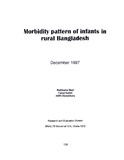| dc.contributor.author | Gazi, Rukhsana | |
| dc.contributor.author | Karim, Fazlul | |
| dc.contributor.author | Chowdhury, AMR | |
| dc.date.accessioned | 2020-01-16T04:56:09Z | |
| dc.date.available | 2020-01-16T04:56:09Z | |
| dc.date.issued | 1997-12 | |
| dc.identifier.citation | Gazi, R., Karim, F., & Chowdhury, A. (1997, December). Infant feeding practices in rural Bangladesh. Research Reports (1997): Health Studies, Vol - XXI, 126–144. | en_US |
| dc.identifier.uri | http://hdl.handle.net/10361/13580 | |
| dc.description.abstract | This report is part of a prospective study Investigating the consequences of low birth weight on Infant
growth, morbidity and feeding practices in rural Bangladesh. The study registered 644 infants who
were followed-up for one year of their age. The study was conducted in three unions of Manikganj
district of rural Bangladesh during 1993-1994 to observe the morbidity pattern of infants, assess the
treatment pattern for illnesses, and to study the consequence of Low birth weight (LBW) on morbidity
during infancy. The overall prevalence of illness was 4.6% among infants aged under 1 year. ARI was
most prevalent morbidity among infants under 1 year. An infant suffers from 3-4 episodes of ARI or 2
episodes of diarrhoea or 1 episodes of skin infection during the first year of life. Among infants of 5-12
month old, diarrhoeal disorders (watery, mucoid or bloody type) occurred more frequently comparison
to infants of 1-4 months old. Low socioeconomic condition, illiteracy of parents. poor and unhygienic
living condition, might be linked with infant morbidity. We found high morbidity prevalence among
LBW infants compared to normal or high birth weight infants, but this difference was not statistically
significant. Among infants who received any treatment, 71% got allopathic treatment, the main
treatment provider being the village doctors. A large proportion of infants did not receive any treatment
due to the perception that ··tor mild Illness treatment is not necessary. Community should get health
education on prevention, care and danger signs of major illnesses such as ARI and diarrhoea.
Provision of sanitary latrines, safe water, and promotion of health education on personal hygiene and
environmental sanitation might reduce the risk of morbidity among infants. | en_US |
| dc.language.iso | en | en_US |
| dc.publisher | BRAC Research and Evaluation Division (RED) | en_US |
| dc.subject | Infants | en_US |
| dc.subject | Morbidity pattern | en_US |
| dc.subject | Rural Bangladesh | en_US |
| dc.subject | Low birth weight (LBW) | en_US |
| dc.subject.lcsh | Infants--Care | |
| dc.subject.lcsh | Mothers--Mortality | |
| dc.subject.lcsh | Rural health--Bangladesh. | |
| dc.title | Morbidity pattern of infants in rural Bangladesh | en_US |
| dc.type | Research report | en_US |

